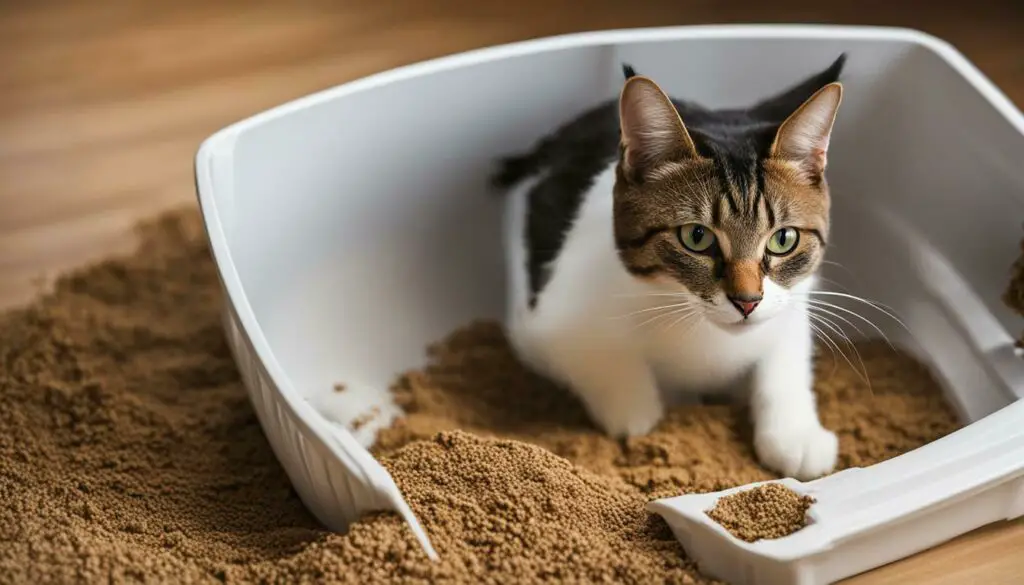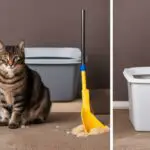Cats playing in the litter box is a common behavior that can stem from various factors. While it may seem playful and innocent, it could also be a sign of underlying issues. Understanding why cats engage in this behavior is essential for addressing any potential problems and ensuring their well-being.
One possible reason why cats play in the litter box is because they enjoy the act of digging and burying their waste. It provides them with a sense of satisfaction and fulfillment. Additionally, playing in the litter box can serve as a way for cats to mark their territory or communicate specific messages to other cats in the household.
A cramped or dirty litter box can also prompt cats to engage in play behavior. If the litter box is too small or filled with too much waste, cats may find it more appealing to play in it rather than use it for its intended purpose. Providing a spacious and clean litter box can help discourage this behavior.
If your cat’s play behavior in the litter box becomes excessive or problematic, it is advisable to seek professional guidance from a veterinarian or an applied animal behaviorist. They can provide tailored solutions and recommendations to address any underlying issues that may be contributing to this behavior.
Key Takeaways:
- Cats may play in the litter box because they enjoy digging and burying their waste.
- Playing in the litter box can also be a way for cats to mark their territory or communicate messages.
- A cramped or dirty litter box can prompt cats to engage in play behavior.
- Consulting a veterinarian or applied animal behaviorist is recommended if excessive play behavior in the litter box becomes a concern.
- Other litter box problems may include surface preference, litter preference or aversion, location preference or aversion, inability to use the litter box, and negative litter box association.
Why Do Cats Play in the Litter Box?
Understanding why cats play in the litter box can help us address any potential issues. While cat behavior can sometimes be perplexing, there are several reasons why our feline friends engage in this peculiar behavior.
One possible explanation is that cats simply enjoy the act of digging and burying their waste. It’s a natural instinct for them, similar to how they would dig in sand or soil in the wild. This behavior provides mental stimulation and entertainment for cats, as they engage in a satisfying activity that mimics their natural hunting and burying behaviors.
Another reason for cats playing in the litter box is to mark their territory or indicate that the litter box needs attention. By scratching and pawing at the litter, cats release their scent and leave visual marks, signaling to other cats that this area is claimed. It can also be a way for them to communicate with their owners, indicating that the litter box requires more litter or needs to be cleaned.
To address excessive play behavior in the litter box, it’s important to consider the conditions of the litter box itself. A cramped or dirty litter box can prompt cats to play in it as a way of seeking a more comfortable space or expressing their dissatisfaction. Providing a quiet and private location for the litter box, as well as regularly cleaning and maintaining it, can help alleviate this behavior.
| Common Reasons Why Cats Play in the Litter Box | Potential Solutions |
|---|---|
| Enjoyment of digging and burying | Ensure the litter box has sufficient depth of litter for digging and provide interactive toys and scratching posts for play stimulation. |
| Marking territory and signaling | Ensure the litter box is adequately cleaned and maintained, and consider providing additional litter boxes in multiple locations. |
| Cramped or dirty litter box | Regularly clean and maintain the litter box, providing a spacious and clean environment for your cat. |
If your cat’s play behavior in the litter box becomes a concern, it’s always advisable to seek professional guidance from a veterinarian or applied animal behaviorist. They can provide tailored solutions to address any underlying issues contributing to this behavior and help ensure a happy and healthy environment for your feline companion.
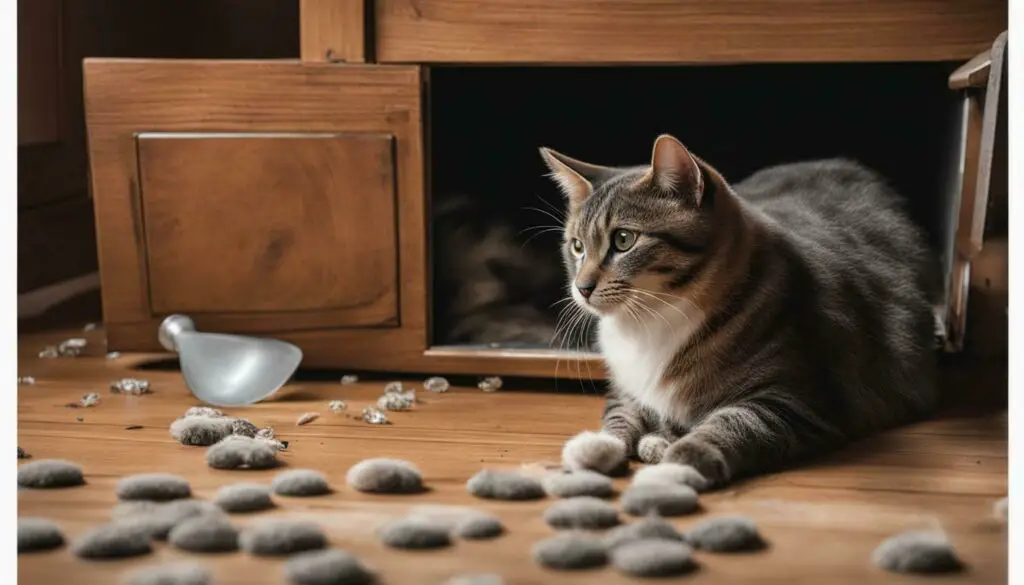
The Enjoyment of Digging and Burying
For many cats, the act of digging and burying in the litter box is a source of entertainment. It taps into their natural instincts and provides them with a mentally and physically stimulating activity. The feeling of digging through the litter, covering their waste, and creating a cozy spot can be highly satisfying for our feline friends. So, why do cats find such joy in this behavior?
One reason is that digging and burying mimics their ancestral behavior in the wild. Cats are instinctively inclined to cover their waste to avoid attracting predators or potential threats. When they engage in this behavior, it gives them a sense of security and helps them establish a safe and clean territory. It’s fascinating to see how these instincts are still present in our modern-day domestic cats.
Moreover, digging and burying in the litter box can also serve as a form of mental and physical exercise for cats. It allows them to engage their muscles, stretch their limbs, and release pent-up energy. The repetitive motion of digging is not only physically stimulating but also mentally satisfying, offering a form of enrichment that can help prevent boredom.
| Benefits of Digging and Burying in the Litter Box |
|---|
| Physical exercise |
| Mental stimulation |
| Instinctual satisfaction |
| Territory establishment |
Understanding the enjoyment cats derive from digging and burying in the litter box allows us to provide them with appropriate outlets for their natural behaviors. By ensuring that they have a clean, comfortable, and well-maintained litter box, we can encourage healthy litter box habits. Additionally, providing interactive litter box toys or puzzle feeders can further stimulate their innate desires to dig and engage in play.
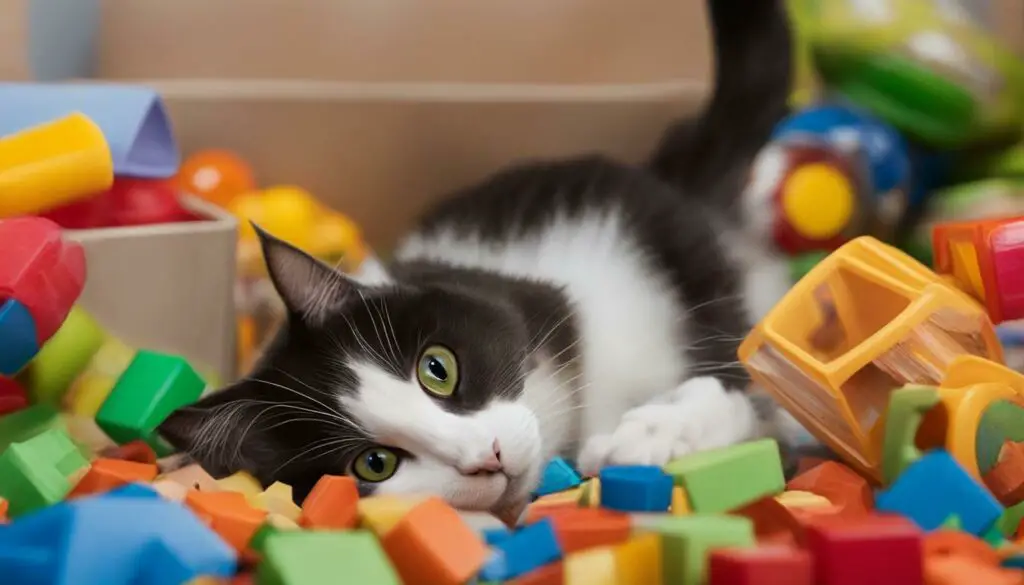
Key takeaways:
- Cats find pleasure in digging and burying in the litter box due to instinctual reasons and the satisfaction it brings.
- This behavior offers cats mental and physical stimulation, serving as a natural form of exercise and enrichment.
- By understanding and catering to their natural behaviors, we can promote healthy litter box habits and overall well-being for our feline companions.
References:
Feline behavior explained: Why cats love to dig in the litter box.” Catological. Accessed March 10, 2022. https://www.catological.com/why-cats-dig-in-litter-box/
Marking Territory and Signaling
Cats may use the litter box as a means of communication, asserting their presence or sending signals to other cats. While it may seem strange to us, this behavior is rooted in their natural instincts. By engaging in play behavior in the litter box, cats leave their scent and mark their territory. This can be especially important in multi-cat households where cats need to establish boundaries.
According to experts, this behavior is generally harmless as long as it doesn’t become excessive. However, if your cat is constantly playing in the litter box and ignoring their actual needs, it may be a sign that something is amiss. It’s important to ensure that your cat feels secure and comfortable in their environment to reduce the need for excessive marking and signaling behavior.
To address this, provide your cat with plenty of opportunities for environmental enrichment and play. Interactive toys and scratching posts can help redirect their energy and satisfy their natural instincts. Additionally, creating a calm and peaceful environment for the litter box location can help reduce the need for excessive marking behavior. Consider placing the litter box in a quiet and private area where your cat feels safe.
| Signs of Excessive Marking and Signaling | Solutions |
|---|---|
| Consistent playing in the litter box | Consult a veterinarian or applied animal behaviorist for guidance |
| Increased aggression or urine marking | Ensure ample resources and provide environmental enrichment |
| Changes in litter box usage patterns | Check for any medical issues and address them accordingly |
Remember, if your cat’s play behavior in the litter box becomes a concern, it’s always best to seek professional guidance. A veterinarian or applied animal behaviorist can help diagnose any underlying issues and provide tailored solutions to address the problem. By understanding and addressing the reasons behind your cat’s play behavior in the litter box, you can ensure their overall well-being and a harmonious living environment for everyone.
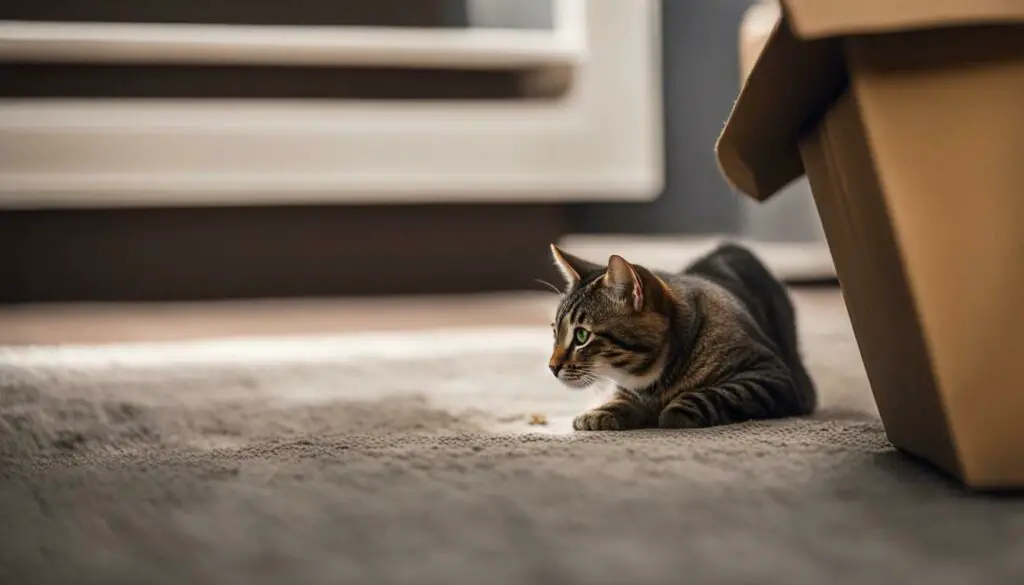
Addressing Litter Box Conditions
Ensuring a clean, private, and comfortable litter box environment is essential to discourage excessive play behavior. Cats may engage in play behavior in the litter box due to various reasons, including their enjoyment of digging and burying waste, marking territory, or signaling their needs. However, if this behavior becomes problematic or disruptive, it is important to address the underlying conditions that may contribute to it.
One factor to consider is the physical condition of the litter box itself. Cats prefer a clean and well-maintained litter box, so regular cleaning is crucial. Remove waste promptly and scoop the litter box daily to keep it fresh. Additionally, consider using unscented litter, as strong odors can be aversive to cats.
Location preference or aversion is another aspect to take into account. Cats appreciate privacy when using the litter box, so ensure that it is placed in a quiet and secluded area of the house. Avoid high-traffic or noisy areas that may disturb their elimination process.
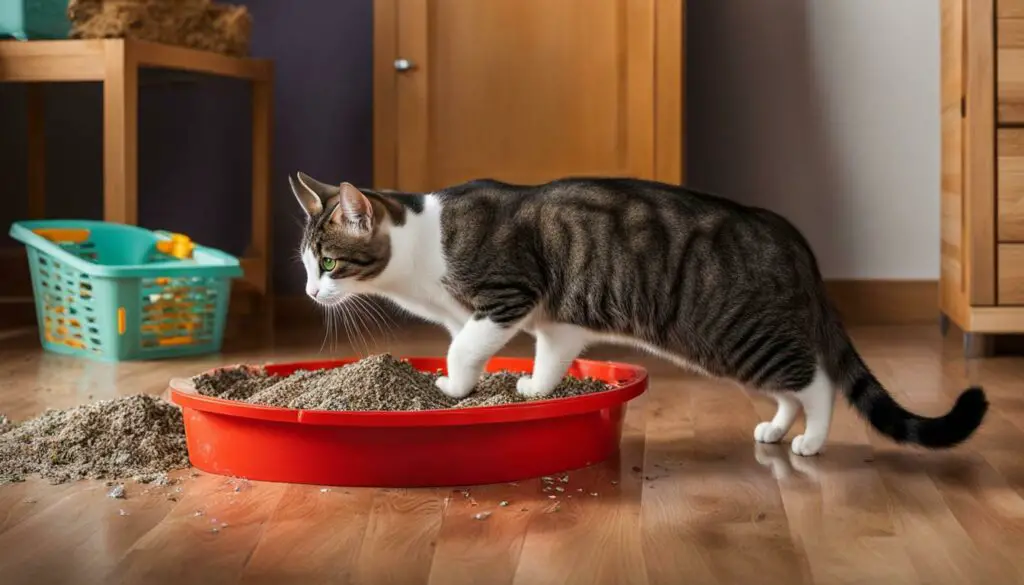
Providing multiple litter boxes throughout the home is also important, particularly in multi-cat households. Cats have preferences for different surfaces and may have individual preferences for litter boxes. By offering variety, you can cater to each cat’s needs and reduce the likelihood of litter box problems.
Additionally, it is crucial to address any medical issues or stress that may be contributing to the cat’s play behavior in the litter box. Medical conditions such as urinary tract infections or digestive disorders can cause discomfort and lead to improper litter box use. If you notice any changes in your cat’s litter box behavior, it is advisable to consult a veterinarian for a thorough examination and appropriate treatment.
| Common Litter Box Problems | Potential Solutions |
|---|---|
| Surface preference | Provide litter boxes with different types of litter (clay, silica, etc.) to accommodate individual preferences. |
| Litter preference or aversion | Experiment with various types and textures of litter to find the one most appealing to your cat. |
| Location preference or aversion | Place litter boxes in quiet, private areas away from noise and traffic. |
| Inability to use the litter box | Consider providing larger litter boxes with lower sides or ramps for easier access. |
| Negative litter box association | Gradually reintroduce positive associations with the litter box using treats or play sessions near the box. |
By addressing litter box conditions and providing a clean, appropriate, and stress-free environment, you can help your cat maintain proper litter box habits and minimize any undesirable play behavior in the litter box.
The Impact of a Cramped or Dirty Litter Box
Cats may resort to play behavior in the litter box when they feel discomfort or dissatisfaction with the conditions. A cramped or dirty litter box can prompt cats to dig, paw, and play in an attempt to find a more comfortable spot or cover their waste adequately. This behavior may indicate that the litter box needs attention and maintenance.
It is essential to provide enough space for your cat to move comfortably within the litter box. If the box is too small or overcrowded, your cat may feel confined or anxious, leading to play behavior. Consider using a larger litter box or providing multiple litter boxes in different areas of your home to accommodate your cat’s preferences.
Regular cleaning and maintenance of the litter box are crucial. Cats have a heightened sense of smell, and a dirty litter box can be repulsive to them. Cleaning the litter box at least once a day, removing clumps, and replacing the litter as needed can help prevent play behavior and ensure your cat’s comfort.
| Causes of Play Behavior in the Litter Box | Solutions |
|---|---|
| A cramped litter box | – Provide a larger litter box or additional ones – Ensure ample space for your cat to move |
| A dirty litter box | – Clean the litter box regularly – Replace litter as needed |
| Overcrowding | – Provide multiple litter boxes in different areas – Avoid placing litter boxes near each other |
| Litter preferences | – Experiment with different types of litter – Observe your cat’s preferences and adjust accordingly |
Remember, understanding your cat’s behavior in the litter box is crucial for their overall well-being. If play behavior in the litter box becomes excessive or problematic, it is recommended to consult a veterinarian or an applied animal behaviorist. They can provide professional guidance tailored to your cat’s specific needs and help you address any underlying issues that may contribute to this behavior.
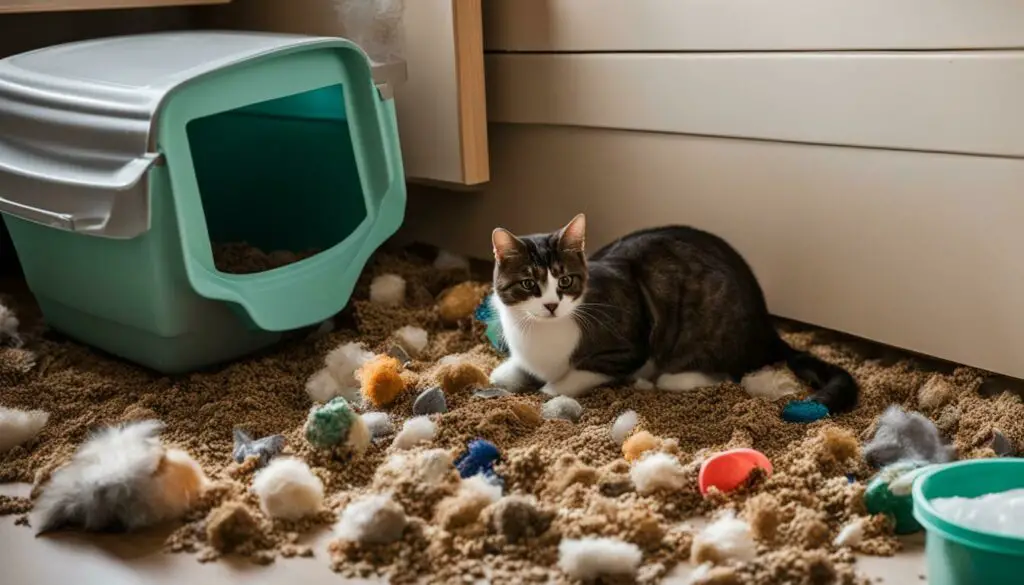
Seeking Veterinary Advice
If your cat’s play behavior in the litter box becomes problematic, consulting a veterinarian or applied animal behaviorist is recommended. These professionals can provide valuable insights into your cat’s behavior and help address any underlying issues that may be contributing to this behavior.
During your consultation, the veterinarian or behaviorist will assess your cat’s overall health and well-being. They may ask you questions about your cat’s litter box habits, their daily routine, and any recent changes in their environment. This information will help them understand the context in which the play behavior is occurring.
Once they have gathered all the necessary information, the veterinarian or behaviorist can offer personalized solutions tailored to your cat’s specific needs. This may include recommendations for environmental adjustments, litter box management, behavioral modifications, or even medical interventions if necessary.
Remember, seeking professional advice is crucial when dealing with any behavioral issue in your cat. The guidance and expertise of a veterinarian or applied animal behaviorist can make a significant difference in understanding and resolving your cat’s litter box play behavior.

Testimonial
“Consulting a veterinarian was a game-changer for my cat’s litter box play behavior. They provided practical solutions that have significantly improved my cat’s overall litter box habits. I highly recommend seeking professional advice if you’re facing similar issues.”
Summary:
- If your cat’s play behavior in the litter box becomes problematic, consulting a veterinarian or applied animal behaviorist is recommended.
- These professionals can evaluate your cat’s health and behavior to identify any underlying issues contributing to the behavior.
- They will provide personalized solutions and recommendations tailored to your cat’s specific needs.
- It’s important to seek professional guidance to understand and address your cat’s litter box play behavior effectively.
Consultation Highlights:
| Benefits | Key Points |
|---|---|
| Accurate Diagnosis | Identify underlying causes of the play behavior |
| Personalized Solutions | Receive tailored recommendations for your cat |
| Behavioral Modifications | Learn techniques to address the play behavior |
| Improved Litter Box Habits | Find practical strategies to promote proper litter box usage |
Key Takeaways:
- Seek veterinary or applied animal behaviorist advice if your cat’s litter box play behavior becomes problematic.
- Consultation will involve a comprehensive assessment of your cat’s health and behavior.
- Personalized solutions and recommendations will be provided to address the underlying issues.
- Professional guidance is essential for understanding and resolving your cat’s litter box play behavior.
Other Litter Box Problems
Cats can experience various issues related to their litter box usage beyond excessive play behavior. It is important for cat owners to be aware of these problems and take appropriate actions to address them. Some common litter box problems include negative litter box association, inability to use the litter box, surface preference, litter preference or aversion, and location preference or aversion.
Negative litter box association occurs when a cat develops a negative association with their litter box due to a traumatic experience or a negative interaction while using it. This can lead to avoidance of the litter box altogether, resulting in inappropriate elimination behaviors. To overcome negative associations, it is crucial to identify and eliminate any potential sources of stress or fear surrounding the litter box, such as loud noises or an uncomfortable location.
Inability to use the litter box can be caused by physical limitations, such as arthritis or injuries, that make it difficult for cats to access or enter the litter box. Additionally, older cats or those with cognitive decline may struggle with coordination and may have accidents outside the litter box. Providing a litter box with low sides or ramps can help cats with mobility issues to use the litter box more comfortably.
Surface preference, litter preference or aversion, and location preference or aversion are all related to a cat’s individual preferences and sensitivities. Some cats prefer certain surfaces, such as carpet or smooth materials, for eliminating, while others may have aversions to certain types of litter or specific locations for their litter box. Understanding and accommodating a cat’s preferences by offering different litter options or multiple litter boxes in various locations can help prevent litter box problems.
Table: Comparing Different Litter Box Problems
| Litter Box Problem | Description | Solution |
|---|---|---|
| Negative Litter Box Association | Cat has developed a negative association with the litter box. | Identify and eliminate stressors surrounding the litter box Provide a positive and calm environment |
| Inability to Use the Litter Box | Cat has physical limitations that prevent them from using the litter box. | Provide a litter box with low sides or ramps Consider a litter box with easy access |
| Surface Preference, Litter Preference or Aversion | Cat has specific surface or litter preferences or aversions. | Offer various litter options to cater to the cat’s preferences Provide multiple litter boxes with different surfaces |
| Location Preference or Aversion | Cat has a preference or aversion to the location of the litter box. | Place litter boxes in quiet and private areas Offer multiple litter box locations in different areas of the house |
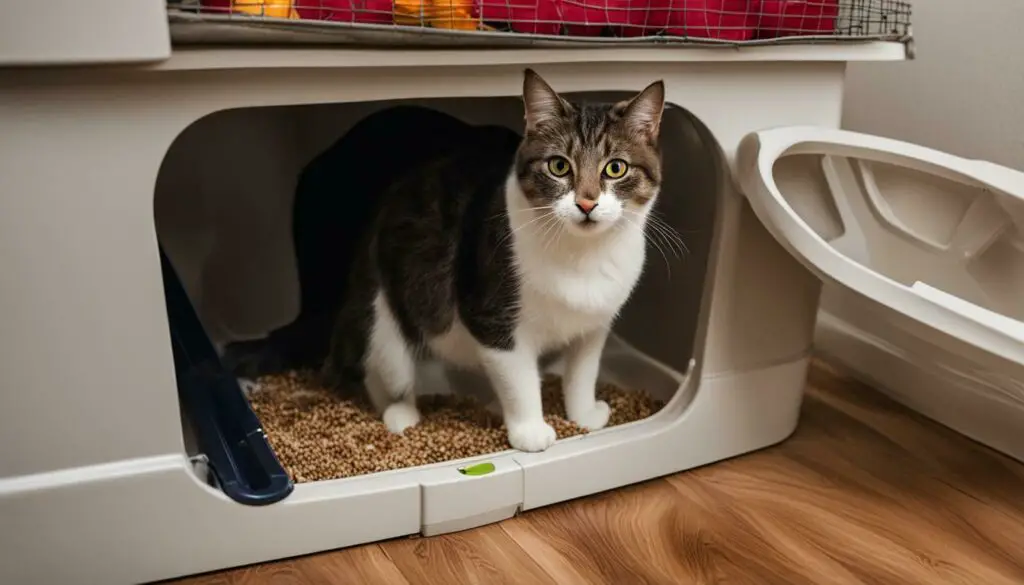
To address these litter box problems, it is important to observe your cat’s behavior, provide a comfortable and clean litter box environment, and make any necessary adjustments to meet their preferences. Regular litter box maintenance, such as scooping and cleaning, is crucial to keep the litter box appealing and odor-free. Additionally, addressing any medical issues or sources of stress can help prevent and resolve litter box problems.
If you are struggling to resolve litter box problems or your cat’s behavior becomes concerning, it is recommended to consult a veterinarian or an applied animal behaviorist for professional guidance and personalized solutions. They can provide expert advice and help you create a plan tailored to your cat’s specific needs, ensuring a positive and stress-free litter box experience for your feline companion.
Providing Ample Litter Boxes
Ensuring an adequate number of litter boxes helps address surface preferences and reduces the likelihood of play behavior. Cats have individual preferences when it comes to their litter box habits, including the type of litter and the location of the box itself. By providing multiple litter boxes throughout the house, you cater to their individual needs and preferences, creating a more inviting and comfortable environment for them.
According to feline behavior experts, the general rule is to have one litter box per cat plus an extra one. For example, if you have two cats, you should ideally have three litter boxes. This helps prevent competition and allows each cat to have their own space for elimination. Additionally, having multiple litter boxes distributed in different areas of the house ensures that cats don’t have to travel long distances to find a suitable spot when they need to go.
When setting up litter boxes, consider placing them in quiet and private areas where cats can feel safe and undisturbed. Avoid placing them near loud appliances, high-traffic areas, or areas where there may be excessive noise or activity. Providing a serene environment helps minimize distractions and encourages cats to use the litter box for their intended purpose rather than engaging in play behavior.
Remember to scoop and clean the litter boxes regularly to maintain cleanliness and freshness. Cats are naturally clean animals, and a dirty litter box can prompt them to look for alternatives, including playing in the box. A good rule of thumb is to scoop the litter box at least once a day and completely replace the litter every one to two weeks, depending on how many cats you have.
| Litter Box Tips: |
|---|
| Provide multiple litter boxes to cater to individual preferences. |
| Place litter boxes in quiet and private areas of the house. |
| Keep litter boxes clean and fresh by scooping regularly. |
| Completely replace the litter every one to two weeks. |
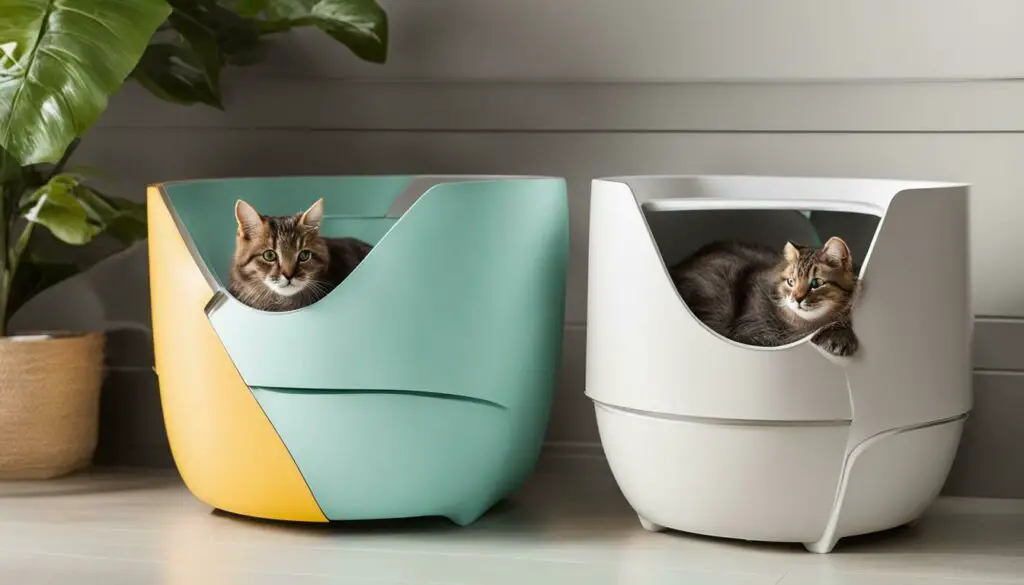
Quote:
“By providing a suitable number of litter boxes in appropriate locations, you can help your cats feel more comfortable and reduce unwanted play behavior in the litter box.” – feline behavior expert
Choosing the Right Litter Box and Litter
Choosing the right litter box and litter type can make a significant difference in a cat’s litter box behavior. Cats have individual preferences when it comes to the size, shape, and location of their litter box. Some cats prefer covered litter boxes for privacy, while others prefer open ones for easier access. It’s important to observe your cat’s behavior and provide a litter box that suits their needs.
When it comes to litter, there are various options available, such as clumping, non-clumping, scented, unscented, natural, and silica gel litter. Cats have different preferences when it comes to the texture and scent of their litter. Some cats prefer finer textures, while others prefer coarser ones. It’s essential to experiment with different litter types to find the one that your cat finds most comfortable.
Additionally, keeping the litter box clean is crucial. Cats are generally clean animals, and a dirty litter box can deter them from using it. Scooping the litter box daily and changing the litter regularly can help maintain a clean and inviting environment for your cat. Remember to use a litter that clumps well, making it easier to remove the soiled litter and keep the box fresh.
| Litter Box Tips: | Benefits: |
|---|---|
| Provide multiple litter boxes: | Allows cats to have options and avoid overcrowding |
| Place litter boxes in quiet and private areas: | Reduces stress and encourages proper litter box usage |
| Experiment with different litter types: | Finds the litter that your cat prefers, reducing aversion |
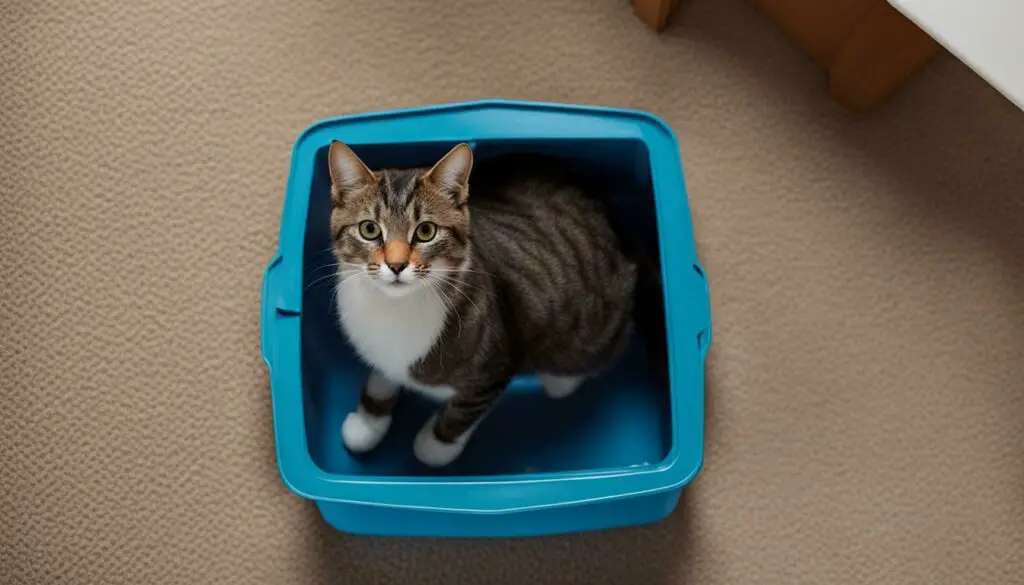
Remember, each cat is unique, and what works for one may not work for another. By paying attention to your cat’s preferences and providing the right litter box and litter, you can create a comfortable and inviting space for them to do their business. Addressing any litter box problems promptly can help maintain a clean and stress-free environment for both you and your feline friend.
Regular Litter Box Maintenance
Regular cleaning and maintenance of the litter box are essential to promote positive litter box habits. Cats are naturally clean animals, and a dirty or smelly litter box can discourage them from using it properly. To ensure your cat’s comfort and hygiene, follow these simple steps:
- Remove waste daily: Scoop out solid waste from the litter box every day. This helps keep the litter box clean and reduces unpleasant odors.
- Replace litter regularly: Depending on the type of litter you use, it’s important to replace it at least once a week. Clumping litters may require more frequent changes, while non-clumping litters can be replaced less often. Remember to check the manufacturer’s recommendations for specific instructions.
- Clean the litter box: Every few weeks, empty the entire litter box and clean it thoroughly with warm water and mild soap. Avoid using strong-smelling cleaners or chemicals that may deter your cat from using the litter box.
By following a regular cleaning routine, you can provide a clean and appealing environment for your cat, promoting their proper litter box usage. It’s also a good opportunity to monitor your cat’s health, as changes in urine or feces consistency can indicate underlying medical issues. If you notice any abnormalities, consult your veterinarian for further guidance.
Remember, cats are creatures of habit, and maintaining a clean litter box helps create a positive association and encourages them to use it consistently. By providing a clean and comfortable space, you can help prevent litter box problems and ensure your cat’s well-being.
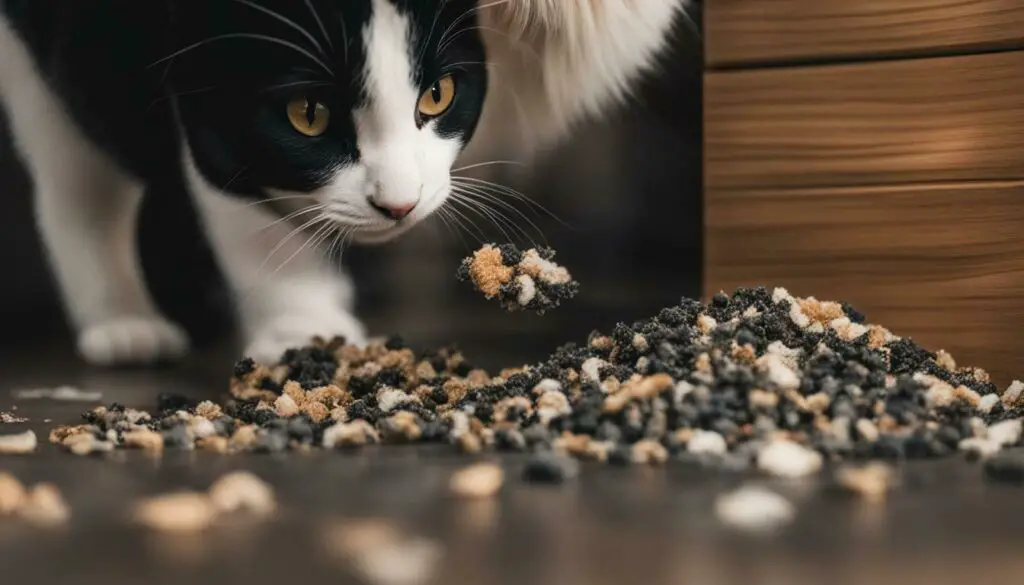
| Benefits of Regular Litter Box Maintenance | Tips for Maintaining a Clean Litter Box |
|---|---|
|
|
Addressing Medical Issues and Stress
Identifying and addressing any underlying medical issues or sources of stress can help resolve litter box problems. Cats may exhibit inappropriate litter box behavior due to various health problems or emotional stressors. It is important to rule out any medical conditions that could be causing discomfort or pain.
Common medical issues that can lead to litter box problems include urinary tract infections, bladder stones, and gastrointestinal disorders. These conditions may cause a cat to associate the litter box with pain, leading them to avoid using it altogether or exhibit abnormal behaviors such as excessive digging or playing.
Stressful situations, such as changes in the household, introduction of new pets, or a lack of environmental enrichment, can also contribute to litter box problems. Cats are sensitive creatures, and any disruptions to their routine or environment can cause anxiety and behavioral changes.
Consulting with a veterinarian is crucial in addressing medical issues and stress-related problems. They can perform a thorough examination, run diagnostic tests if necessary, and provide appropriate treatment options. Additionally, a veterinarian may recommend behavior modification techniques or suggest environmental changes to help alleviate stress and encourage proper litter box usage.
| Common Medical Issues | Signs and Symptoms |
|---|---|
| Urinary Tract Infections | Frequent urination, blood in the urine, straining to urinate |
| Bladder Stones | Painful urination, frequent licking of genital area, presence of blood in urine |
| Gastrointestinal Disorders | Diarrhea, constipation, decreased appetite |
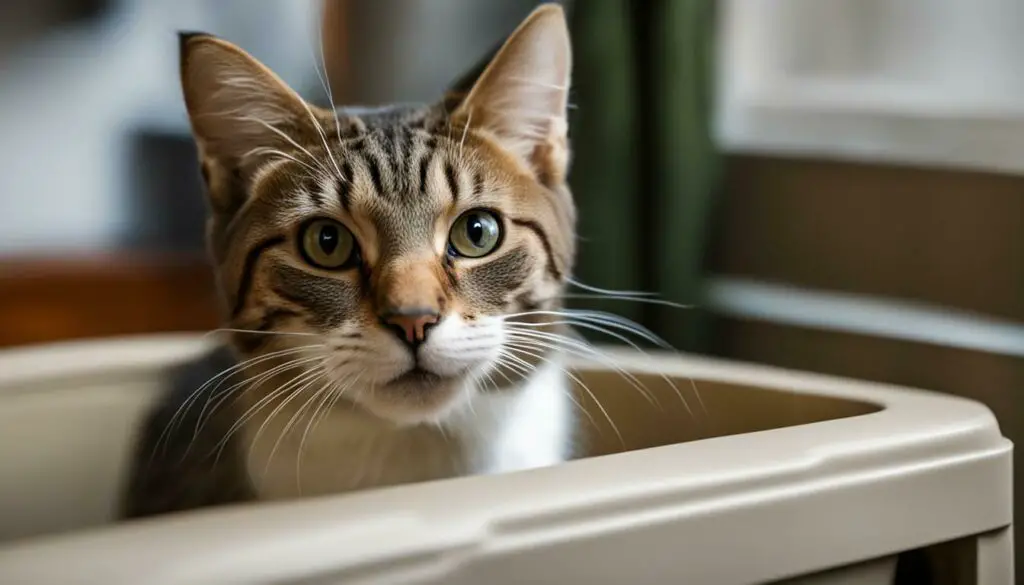
Conclusion
By implementing practical solutions and addressing potential underlying issues, we can ensure that our feline friends have a positive litter box experience. Cat playing in the litter box is a common behavior, but it can also be a sign of underlying issues that need to be addressed.
Cats may engage in play behavior in the litter box because they enjoy digging and burying their waste. It can also serve as a way for them to mark their territory or indicate that the litter box needs more litter. However, a cramped or dirty litter box can prompt cats to play in it as well, impacting their overall litter box habits.
To prevent unwanted play behavior in the litter box, it is important to provide a quiet and private location for the litter box. This can help cats feel more comfortable and reduce their need to engage in excessive digging and playing. Additionally, consulting a veterinarian or an applied animal behaviorist can provide valuable insights and solutions when dealing with problematic litter box behavior.
Other litter box problems that cats may face include surface preference, litter preference or aversion, location preference or aversion, inability to use the litter box, and negative litter box association. To address these issues, it is crucial to provide ample litter boxes, use the right type of litter box and litter, clean the litter box regularly, and address any medical issues or stress that may contribute to the problem.
FAQ
Why do cats play in the litter box?
Cats may play in the litter box because they enjoy digging and burying their waste. It can also be a way for them to mark their territory or indicate that the litter box needs more litter.
What can cause a cat to play excessively in the litter box?
A cramped or dirty litter box can cause cats to play in it excessively.
How can I address litter box conditions that contribute to play behavior?
Providing a quiet and private location for the litter box can help alleviate this behavior.
When should I seek professional guidance for excessive play behavior in the litter box?
If the excessive digging and playing become problematic, it is recommended to consult a veterinarian or an applied animal behaviorist for solutions.
What other litter box problems can cats face?
Cats may also experience surface preference, litter preference or aversion, location preference or aversion, inability to use the litter box, and negative litter box association.
How can I address potential litter box problems?
Taking actions such as providing enough litter boxes, using the right type of litter box and litter, cleaning the litter box regularly, and addressing any medical issues or stress can help resolve litter box problems.

